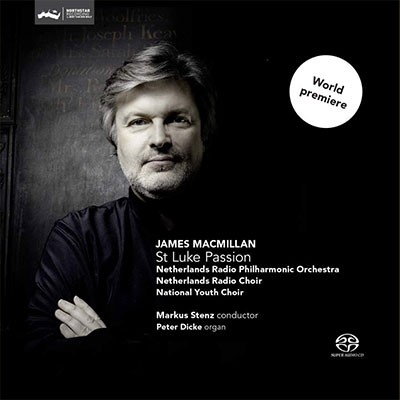St Luke Passion
(2012-13)The Bible, Revised Standard Version (E)
1.2(II=corA).1.2(II=dbn)-2.2.0.0-timp-org-strings
Abbreviations (PDF)
Boosey & Hawkes
Choral level of difficulty: 4-5 (5 greatest)
MacMillan’s St John Passion was an almost operatic approach to the setting of the Passion story in John’s version and what MacMillan described as ‘examining the human drama’. But his St Luke Passion written five years later between 2012 and 2013 took a completely new direction: ‘St Luke has a special appeal for me. As well as relating Christ’s life and teachings, Luke is concerned with the idea of the Kingdom of God which points forward to the same author’s Acts of the Apostles. This started me thinking about a more spiritual, inward, and pared-back approach to create a focused work about an hour long’.
The orchestration is economical 1:2 (+Cor anglais):1:2 (+Contrabassoon): 2:2:0:0: Timps: organ: strings. The text of the Passion narrative is preceded by a Prelude mostly from the first chapter of Luke’s Gospel, and followed by a Postlude concluding with a moving passage from Luke’s Acts. There are no soloists. A children’s choir in three parts adds to the SATB chorus which acts out the parts normally taken by soloists. So, for instance, the ‘recitative’ narrative as we might expect it at the start of the Chapter 22 first movement of the Passion story begins ‘Now the feast of the Unleavened Bread drew near which is called the Passover…’ and this is taken by tenors and basses singing strongly, delivering the narration powerfully together and with absolute clarity. The part of Christus is given to the Children’s choir, a really fresh concept, but emphasizing Christ’s innocence in this whole saga. They carry a crucial role and this element of the performance needs to be really secure – but there are many fine youth choirs who would relish this task.
One of the impressive elements in this work is the utter clarity of the words through the orchestration which is often very spare, colourful and gentle. This makes the outbursts – and there are really huge moments in this work – so much more shocking by contrast with the surroundings. As so often, there are truly beautiful choral passages. A wonderful example is the passage at figure 33 in Chapter 22 ‘And there appeared to him an angel from heaven…’. MacMillan has such an ear for choral sonority. The freshness of approach is also very clear in the passage following this where Jesus asks the disciples why they are sleeping. But this is not accusatory, rather resigned, and accepting of the human condition.
Chapter 23 begins with the drama of the impending climax to the story as the trial gets under way. The febrile atmosphere is so brilliantly captured in the section with buzzing strings and uneven bar lengths as the sopranos and altos describe Herod’s questioning of Jesus and his contempt for him before handing him back to Pilate. The organ punctuates these sections with massive clusters on full organ. There are echoes of The Seven Last Words from the Cross perhaps not surprisingly given the description of the same event. The portrayal of Jesus’ death is incredibly powerful and has a funeral march ostinato built into it as the strings wind around leading to the choir introducing the Centurion’s assertion that Jesus was indeed innocent. The movement ends with the statement from the horns of the great Passion chorale shining through the massively discordant screaming of the rest of the orchestra. The Postlude is based around chanting tenors and basses and sopranos and altos around which the orchestra play free figures for much of the movement. The choir moves to humming while wind and string arabesques seem to lead us beyond the world and beyond the horrors of the whole saga just recounted to the promise of the ‘new heaven and new earth’.
This is another truly remarkable work which many more choirs will feel able to tackle than might have been the case with MacMillan’s St John Passion. It is not easy, but the choral parts are to a far greater degree manageable and will be within the grasp of a good choral society who can sing rhythmically and confidently. It needs a confident approach and a choir from which both men and women will be able to sing MacMillan’s considerable lines with good blended tone and clarity of diction. This goes, too, for the Children’s choir who have a very meaty role to play throughout which will be an exciting project for boys, girls or a mixture of both.
Repertoire Note by Paul Spicer
"MacMillan’s musical language is crystal clear. Musically wrenching sounds combine seamlessly with a sonorous and eminently singable discourse. The modest orchestral forces provide some wonderful effects with diffuse chords, subtle veils of sound and ominous timpani pounding, but other elements of the text’s portrayal are purposely restrained. Just as the end seems near, MacMillan delivers a comforting ‘flashforward’ with fragments from the scriptures describing Christ’s resurrection and ascension. The long tutti flurries and choral murmurs are a fitting conclusion to this major, yet understated work."
De Volksrant

Netherlands Radio Philharmonic Orchestra/Netherlands Radio Choir/
National Youth Choir/Peter Dicke/Markus Stenz
Challenge Classics CC72671

